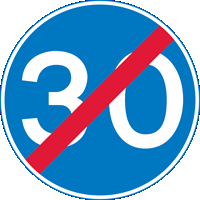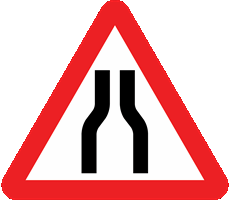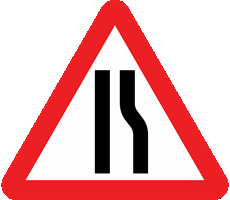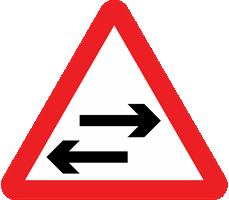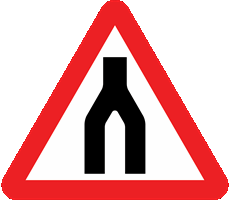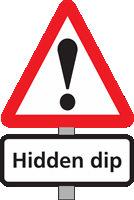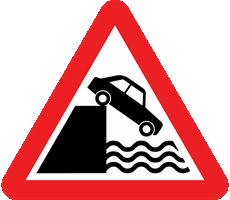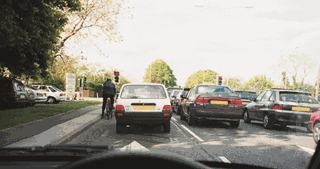You have 57 minutes to answer 50 multiple choice driving theory test questions. You need to answer at least 43 out of 50 questions correctly to pass. You can review your answer after each question or you can review all of your answers at the end of the test. Best of luck!
Test Quick View
Click question box to reveal the correct answer. You can print these questions out by clicking the printer icon.
1. Why shouldn't you gesture people to cross, by waving or otherwise, at pedestrian crossings?
Mark one answer
B
C
D
Correct Answer: A
Explanation: Reduce your speed and get ready to stop if you see people waiting at a pedestrian crossing. Don't prompt them to cross the road by gesturing to them. This could be potentially dangerous as other drivers may not be able to stop in time if they fail to see the pedestrians.
Explanation: Reduce your speed and get ready to stop if you see people waiting at a pedestrian crossing. Don't prompt them to cross the road by gesturing to them. This could be potentially dangerous as other drivers may not be able to stop in time if they fail to see the pedestrians.
B
C
D
Correct Answer: B
Explanation: Because motorcycles are harder to see than larger vehicles, riders sometimes use dipped headlights during the day to make themselves more visible.
Explanation: Because motorcycles are harder to see than larger vehicles, riders sometimes use dipped headlights during the day to make themselves more visible.
Correct Answer: D
Explanation: The national speed limit for motorcycles and cars on a motorway is 70 mph. You should aim to be in the left-hand lane whenever possible, using the lanes to the right for overtaking. Ensure you're in the left-hand lane well before your exit junction, and reduce your speed once you're on the slip road. Keep an eye out for sharp bends and queues on slip roads.
Explanation: The national speed limit for motorcycles and cars on a motorway is 70 mph. You should aim to be in the left-hand lane whenever possible, using the lanes to the right for overtaking. Ensure you're in the left-hand lane well before your exit junction, and reduce your speed once you're on the slip road. Keep an eye out for sharp bends and queues on slip roads.
Correct Answer: C
Explanation: This sign indicates that the 30 mph minimum speed limit has ended. Signs with red slashes through them signal the end of a restriction.
Explanation: This sign indicates that the 30 mph minimum speed limit has ended. Signs with red slashes through them signal the end of a restriction.
Correct Answer: C
Explanation: It's permitted to overtake on either side on a one-way street. Take the usual precautions, checking your mirrors and blind spots before overtaking. Pay attention to road markings and signs, and make sure overtaking doesn't leave you in the wrong lane for your destination.
Explanation: It's permitted to overtake on either side on a one-way street. Take the usual precautions, checking your mirrors and blind spots before overtaking. Pay attention to road markings and signs, and make sure overtaking doesn't leave you in the wrong lane for your destination.
Correct Answer: A
Explanation: This is a 'no right turn' sign. It may be that turning right at the junction would be particularly dangerous, or that the adjoining road is a one-way road.
Explanation: This is a 'no right turn' sign. It may be that turning right at the junction would be particularly dangerous, or that the adjoining road is a one-way road.
Correct Answer: D
Explanation: The dual carriageway will shortly become a single carriageway. If overtaking, be sure that you're back into the left lane well before the dual carriageway ends.
Explanation: The dual carriageway will shortly become a single carriageway. If overtaking, be sure that you're back into the left lane well before the dual carriageway ends.
Correct Answer: A
Explanation: This sign indicates that overtaking is not allowed here. This could be because of a hidden dip in the road. Hidden dips are particularly dangerous, as they can hide oncoming vehicles, pedestrians, cyclists, horse riders, and parked vehicles.
Explanation: This sign indicates that overtaking is not allowed here. This could be because of a hidden dip in the road. Hidden dips are particularly dangerous, as they can hide oncoming vehicles, pedestrians, cyclists, horse riders, and parked vehicles.
Correct Answer: C
Explanation: 60 mph is the maximum speed on a single carriageway road. Be aware of this especially in instances where a national speed limit dual carriage way filters down to a single lane. The speed limit will change but may not be signposted. Slow down gradually ahead of the change in the road. Learn speed limits for different roads from The Highway Code.
Explanation: 60 mph is the maximum speed on a single carriageway road. Be aware of this especially in instances where a national speed limit dual carriage way filters down to a single lane. The speed limit will change but may not be signposted. Slow down gradually ahead of the change in the road. Learn speed limits for different roads from The Highway Code.
Correct Answer: D
Explanation: This lights indicate a school crossing nearby. Keep your speed low and be prepared to stop if children are crossing.
Explanation: This lights indicate a school crossing nearby. Keep your speed low and be prepared to stop if children are crossing.
Correct Answer: D
Explanation: This sign indicates the end of a temporary motorway restriction. The start of a temporary restriction is indicated by signs with flashing amber lights.
Explanation: This sign indicates the end of a temporary motorway restriction. The start of a temporary restriction is indicated by signs with flashing amber lights.
Correct Answer: D
Explanation: Taking a 15-minute break every two hours is the recommended balance, and it's suggested you plan a trip with this in mind. Doing so will help you stay focused on driving safely.
Explanation: Taking a 15-minute break every two hours is the recommended balance, and it's suggested you plan a trip with this in mind. Doing so will help you stay focused on driving safely.
Correct Answer: D
Explanation: Driving with under-inflated tyres will worsen fuel consumption. Check your tyre pressures once per week. Low-pressure tyres have higher 'rolling resistance,' making the engine work harder.
Explanation: Driving with under-inflated tyres will worsen fuel consumption. Check your tyre pressures once per week. Low-pressure tyres have higher 'rolling resistance,' making the engine work harder.
14. What should you do to ensure your brakes are working properly after driving through deep water?
Mark one answer
B
C
D
Correct Answer: A
Explanation: Driving through water can leave your brakes wet, making them less efficient. Gently using your brakes as you continue will dry them quickly.
Explanation: Driving through water can leave your brakes wet, making them less efficient. Gently using your brakes as you continue will dry them quickly.
Correct Answer: C
Explanation: You should be cautious at unmarked junctions, especially where obstructions - such as hedges, parked cars, and buildings - block your view. In summer months, foliage may have grown to obstruct your view further, so take extra care.
Explanation: You should be cautious at unmarked junctions, especially where obstructions - such as hedges, parked cars, and buildings - block your view. In summer months, foliage may have grown to obstruct your view further, so take extra care.
Correct Answer: A
Explanation: This sign warns of a nearby quayside or river bank, showing that there could be a steep drop into water nearby. There may or may not be a barrier along the edge, and the road near the drop is likely to be slippery. Take care.
Explanation: This sign warns of a nearby quayside or river bank, showing that there could be a steep drop into water nearby. There may or may not be a barrier along the edge, and the road near the drop is likely to be slippery. Take care.
Correct Answer: C
Explanation: If the left-hand pavement is closed, be aware that there could be pedestrians in the road. Take extra care and reduce your speed.
Explanation: If the left-hand pavement is closed, be aware that there could be pedestrians in the road. Take extra care and reduce your speed.
Correct Answer: C
Explanation: Flashing red lights tell you that a lane is closing, and that you should move to another lane. If flashing red lights indicate that all lanes are closing, all traffic on the motorway should stop.
Explanation: Flashing red lights tell you that a lane is closing, and that you should move to another lane. If flashing red lights indicate that all lanes are closing, all traffic on the motorway should stop.
Correct Answer: D
Explanation: Unless you are overtaking a slower vehicle, you should aim to be in the left-hand lane of the motorway at all times. After overtaking, move back into the left-hand lane, ensuring there is enough space between you and the vehicle you've just overtaken.
Explanation: Unless you are overtaking a slower vehicle, you should aim to be in the left-hand lane of the motorway at all times. After overtaking, move back into the left-hand lane, ensuring there is enough space between you and the vehicle you've just overtaken.
Correct Answer: C
Explanation: Traffic officers are allowed to stop and direct traffic on motorways and some 'A' class roads, even though they don't have enforcement powers. Traffic officers work in partnership with police at incidents. They can be recognised by their orange-and-yellow reflective jackets and the yellow-and-black markings on their vehicles.
Explanation: Traffic officers are allowed to stop and direct traffic on motorways and some 'A' class roads, even though they don't have enforcement powers. Traffic officers work in partnership with police at incidents. They can be recognised by their orange-and-yellow reflective jackets and the yellow-and-black markings on their vehicles.
21. While on a smart motorway, what does a mandatory speed limit above the hard shoulder indicate?
Mark one answer
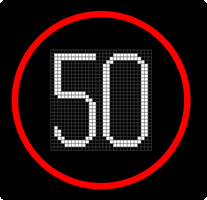
B
C
D
Correct Answer: D
Explanation: This sign indicates that the hard shoulder is being used as a running lane, and that it has a mandatory speed limit of 50 mph. The hard shoulder will still be used by broken down vehicles in this scenario, so look far ahead for any obstructions.
Explanation: This sign indicates that the hard shoulder is being used as a running lane, and that it has a mandatory speed limit of 50 mph. The hard shoulder will still be used by broken down vehicles in this scenario, so look far ahead for any obstructions.
Correct Answer: B
Explanation: Planning your journey to avoid busy periods reduces congestion on the road, and means you'll spend less time queuing. Avoid morning and afternoon rush hours.
Explanation: Planning your journey to avoid busy periods reduces congestion on the road, and means you'll spend less time queuing. Avoid morning and afternoon rush hours.
Correct Answer: C
Explanation: When parking at night on a road with a speed limit greater than 30 mph, you must leave your parking lights on. You should ensure you don't park close to a junction, and park facing the same way as the traffic flow.
Explanation: When parking at night on a road with a speed limit greater than 30 mph, you must leave your parking lights on. You should ensure you don't park close to a junction, and park facing the same way as the traffic flow.
Correct Answer: D
Explanation: Variable speed limits are used to prevent the bunching up of traffic. You'll find variable speed limits in operation on smart motorways during busy periods. Keeping to the speed shown usually improves traffic flow and journey times. Keep an eye out for the speed limit changing as you drive.
Explanation: Variable speed limits are used to prevent the bunching up of traffic. You'll find variable speed limits in operation on smart motorways during busy periods. Keeping to the speed shown usually improves traffic flow and journey times. Keep an eye out for the speed limit changing as you drive.
Correct Answer: C
Explanation: Road tax (also known as vehicle excise duty) can be renewed online or by phone, at the post office, or at vehicle registration offices. You'll need your renewal reminder notice, and may need your MOT certificate.
Explanation: Road tax (also known as vehicle excise duty) can be renewed online or by phone, at the post office, or at vehicle registration offices. You'll need your renewal reminder notice, and may need your MOT certificate.
26. What is the typical overall stopping distance at 40 mph in good, dry conditions?
Mark one answer
B
C
D
Correct Answer: B
Explanation: Your vehicle type, model, and condition all affect stopping distance, as do the road surface, weather conditions, and your reaction time. Pay attention to the road well ahead. Looking for hazards that could emerge reduces the likelihood of you needing to brake suddenly. Additionally, you should always ensure you leave a big enough gap between you and the vehicle in front so you can stop safely.
Explanation: Your vehicle type, model, and condition all affect stopping distance, as do the road surface, weather conditions, and your reaction time. Pay attention to the road well ahead. Looking for hazards that could emerge reduces the likelihood of you needing to brake suddenly. Additionally, you should always ensure you leave a big enough gap between you and the vehicle in front so you can stop safely.
27. On a motorway, what can you do to reduce the risk of an accident if the vehicle behind you is following too closely?
Mark one answer
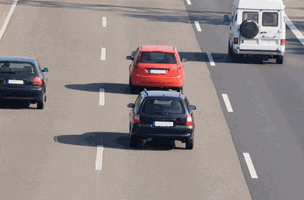
B
C
D
Correct Answer: C
Explanation: If the vehicle behind is too close, you should gently lower your speed to increase the distance between you and the vehicle in front. This provides more space ahead of you in case you need to brake or stop, and reduces the likelihood of collisions. If there is a collision, the gap in front reduces the likelihood of multiple vehicles being involved.
Explanation: If the vehicle behind is too close, you should gently lower your speed to increase the distance between you and the vehicle in front. This provides more space ahead of you in case you need to brake or stop, and reduces the likelihood of collisions. If there is a collision, the gap in front reduces the likelihood of multiple vehicles being involved.
B
C
D
Correct Answer: B
Explanation: Fresh air can help keep you alert when you begin to feel tired, but your first priority should always be using the next service area or motorway exit to find a safe place to rest.
Explanation: Fresh air can help keep you alert when you begin to feel tired, but your first priority should always be using the next service area or motorway exit to find a safe place to rest.
29. What should you do if the back of your vehicle slides right when you're turning left on a slippery road?
Mark one answer
B
C
D
Correct Answer: D
Explanation: If the back of your vehicle swings right as you turn left, keep calm and steer right, into the skid. Watch you don't overcorrect, as this could cause you to skid in the other direction. Driver error is usually the cause of a skid, so think back on what you could have done differently. Icy conditions and tyre wear affect the likelihood of skidding.
Explanation: If the back of your vehicle swings right as you turn left, keep calm and steer right, into the skid. Watch you don't overcorrect, as this could cause you to skid in the other direction. Driver error is usually the cause of a skid, so think back on what you could have done differently. Icy conditions and tyre wear affect the likelihood of skidding.
Correct Answer: A
Explanation: The driver should give the cyclist time and space to pull away. Additionally, since cyclists often filter through stationary traffic, the driver should check their mirrors before moving off.
Explanation: The driver should give the cyclist time and space to pull away. Additionally, since cyclists often filter through stationary traffic, the driver should check their mirrors before moving off.
31. Which of the following will be significantly more expensive following a conviction for driving under the influence of drink or drugs?
Mark one answer
B
C
D
Correct Answer: B
Explanation: Insurance companies usually charge higher premiums to those with drink or drug-driving convictions. This is because you have shown yourself to be a risk for yourself and other road users.
Explanation: Insurance companies usually charge higher premiums to those with drink or drug-driving convictions. This is because you have shown yourself to be a risk for yourself and other road users.
Correct Answer: C
Explanation: It will take time for the alcohol to pass through your friend's body, and drinking coffee or waiting only a few hours won't make a difference. You should recommend they get a lift from someone sober, or take public transport or a taxi. Large amounts of alcohol might mean they're still unfit to drive the next morning.
Explanation: It will take time for the alcohol to pass through your friend's body, and drinking coffee or waiting only a few hours won't make a difference. You should recommend they get a lift from someone sober, or take public transport or a taxi. Large amounts of alcohol might mean they're still unfit to drive the next morning.
33. You are carrying a family of two adults and one child in your car. Who is responsible for ensuring the child wears a seatbelt?
Mark one answer
B
C
D
Correct Answer: C
Explanation: The driver is responsible for ensuring that passengers under 14 are wearing their seatbelts, or that they're secured with an approached child restraint. Both seatbelts and child restraints are designed to save lives and reduce injury.
Explanation: The driver is responsible for ensuring that passengers under 14 are wearing their seatbelts, or that they're secured with an approached child restraint. Both seatbelts and child restraints are designed to save lives and reduce injury.
Correct Answer: B
Explanation: Regular vehicle servicing helps keep your engine running efficiently, improving fuel consumption and reducing emissions.
Explanation: Regular vehicle servicing helps keep your engine running efficiently, improving fuel consumption and reducing emissions.
Correct Answer: B
Explanation: If you have one, a garage is the safest place to keep your car. This will protect your car from both potential thieves and the elements.
Explanation: If you have one, a garage is the safest place to keep your car. This will protect your car from both potential thieves and the elements.
Correct Answer: B
Explanation: Swerving or braking could cause you to lose control, and the vehicle behind may not be prepared for these sudden manoeuvres, leading to a collision. The best thing to do is slow down gently, slowly increasing the separation distance between you and the motorcycle.
Explanation: Swerving or braking could cause you to lose control, and the vehicle behind may not be prepared for these sudden manoeuvres, leading to a collision. The best thing to do is slow down gently, slowly increasing the separation distance between you and the motorcycle.
B
C
D
Correct Answer: C
Explanation: Looking well ahead of you on the road will help reduce the impact of your vehicle on the environment. Anticipating road conditions and hazards ahead helps avoid unnecessary braking and harsh braking, and choosing the appropriate gear for the road ahead reduces engine revs, all of which reduces vehicle wear and improves fuel consumption.
Explanation: Looking well ahead of you on the road will help reduce the impact of your vehicle on the environment. Anticipating road conditions and hazards ahead helps avoid unnecessary braking and harsh braking, and choosing the appropriate gear for the road ahead reduces engine revs, all of which reduces vehicle wear and improves fuel consumption.
Correct Answer: B
Explanation: Tyres in poor condition will lengthen the distance required to stop, as they'll have less grip on the road. Make sure your tyres are in good condition and are correctly inflated.
Explanation: Tyres in poor condition will lengthen the distance required to stop, as they'll have less grip on the road. Make sure your tyres are in good condition and are correctly inflated.
Correct Answer: B
Explanation: You should dip your headlights as soon as the overtaking driver passes you to avoid dazzling them with your headlights. Drop back if necessary to ensure the dipped lights aren't dazzling either.
Explanation: You should dip your headlights as soon as the overtaking driver passes you to avoid dazzling them with your headlights. Drop back if necessary to ensure the dipped lights aren't dazzling either.
40. In which of the following situations would windscreen pillars hinder your view of the road?
Mark one answer
B
C
D
Correct Answer: A
Explanation: Smaller vehicles and road users - pedestrians, motorcyclists, and cyclists - can be hidden by your windscreen pillars. Be sure to move your head to look past them to check the road at bends and junctions.
Explanation: Smaller vehicles and road users - pedestrians, motorcyclists, and cyclists - can be hidden by your windscreen pillars. Be sure to move your head to look past them to check the road at bends and junctions.
Correct Answer: B
Explanation: Some road systems accommodate both trams and motor vehicles. Be wary in these systems, as trams cannot steer to avoid you, and often accelerate very quickly. Driving in road systems with trams can take some getting used to, so plan accordingly.
Explanation: Some road systems accommodate both trams and motor vehicles. Be wary in these systems, as trams cannot steer to avoid you, and often accelerate very quickly. Driving in road systems with trams can take some getting used to, so plan accordingly.
42. Is it allowed to park on zigzag lines by a zebra crossing when there are no available parking spaces elsewhere?
Mark one answer
B
C
D
Correct Answer: A
Explanation: You should never park on these lines, as your vehicle will obstruct the view of the crossing for both drivers and pedestrians. Parking on these lines is an offence.
Explanation: You should never park on these lines, as your vehicle will obstruct the view of the crossing for both drivers and pedestrians. Parking on these lines is an offence.
Correct Answer: D
Explanation: Because of the increased risk, you should only drive in snow if your journey is essential.
Explanation: Because of the increased risk, you should only drive in snow if your journey is essential.
44. In this situation, what should you do if traffic in the left-hand lane starts slowing?
Mark one answer

B
C
D
Correct Answer: A
Explanation: Traffic will often slow as lanes merge. Allow vehicles from the right to merge into the left lane, and ensure there is always a safe gap between you and the vehicle in front, even if someone pulls into the gap.
Explanation: Traffic will often slow as lanes merge. Allow vehicles from the right to merge into the left lane, and ensure there is always a safe gap between you and the vehicle in front, even if someone pulls into the gap.
Correct Answer: B
Explanation: You should use your hazard warning lights to warn traffic behind you of danger ahead on a motorway. They should also be used when your vehicle is causing an obstruction following a breakdown.
Explanation: You should use your hazard warning lights to warn traffic behind you of danger ahead on a motorway. They should also be used when your vehicle is causing an obstruction following a breakdown.
46. Why is it potentially dangerous to leave rear fog lights switched on when they're not required?
Mark one answer
B
C
D
Correct Answer: B
Explanation: Other drivers might think your rear fog lights are your brake lights if you use them in clear weather, and might misunderstand what you're doing. They can also dazzle drivers behind, distracting them from driving safely, particularly at night, in wet conditions, and on motorways. It is illegal to drive in good conditions with fog lights turned on.
Explanation: Other drivers might think your rear fog lights are your brake lights if you use them in clear weather, and might misunderstand what you're doing. They can also dazzle drivers behind, distracting them from driving safely, particularly at night, in wet conditions, and on motorways. It is illegal to drive in good conditions with fog lights turned on.
47. When is it permitted for cars towing trailers to use the right lane on a motorway?
Mark one answer
B
C
D
Correct Answer: D
Explanation: Vehicles towing trailers or caravans are not usually permitted to use the right-most lane, but may do so when all other lanes are closed.
Explanation: Vehicles towing trailers or caravans are not usually permitted to use the right-most lane, but may do so when all other lanes are closed.
Correct Answer: C
Explanation: Driving in an environmentally friendly manner is called ecosafe driving. Your vehicle will produce fewer emissions and use less fuel, saving you money and reducing the impact of your vehicle on the environment.
Explanation: Driving in an environmentally friendly manner is called ecosafe driving. Your vehicle will produce fewer emissions and use less fuel, saving you money and reducing the impact of your vehicle on the environment.
Correct Answer: B
Explanation: Journeys in fog take longer, so you should plan accordingly, and only drive in the first place if your journey is absolutely necessary. If sudden fog is likely to make you late, let anyone you're due to be meeting know. This takes the pressure off you to drive more quickly than is advised in fog, and stops them worrying if you're late.
Explanation: Journeys in fog take longer, so you should plan accordingly, and only drive in the first place if your journey is absolutely necessary. If sudden fog is likely to make you late, let anyone you're due to be meeting know. This takes the pressure off you to drive more quickly than is advised in fog, and stops them worrying if you're late.
Correct Answer: C
Explanation: It is a legal requirement to stop your vehicle if an incident you're involved in causes injury or damage to a person, animal, vehicle, or property. Additionally, it is legally required to stop when a traffic or police officer, traffic warden, school crossing patrol, or traffic light signals you to do so.
Explanation: It is a legal requirement to stop your vehicle if an incident you're involved in causes injury or damage to a person, animal, vehicle, or property. Additionally, it is legally required to stop when a traffic or police officer, traffic warden, school crossing patrol, or traffic light signals you to do so.


